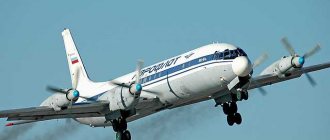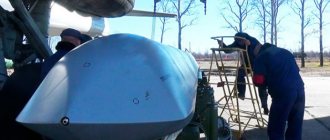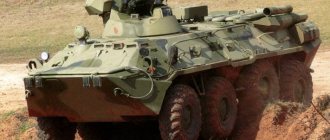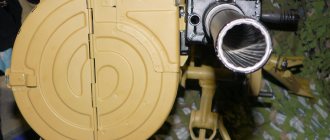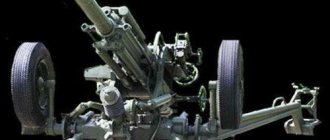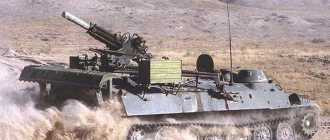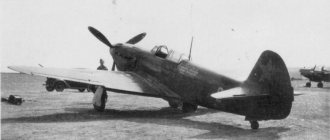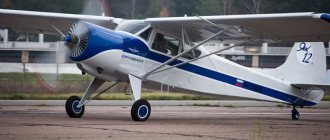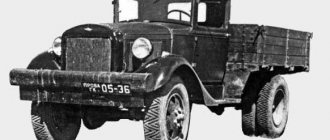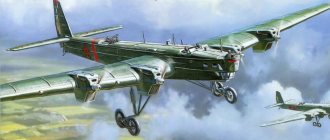The MiG-3 is a Soviet high-speed, high-altitude piston fighter, created on the eve of the Second World War. Due to its design and operational features, the MiG-3 was never able to become a full-fledged front-line fighter.
However, this machine was actively used as an air defense aircraft: the high speed of the fighter at high altitudes allowed Soviet pilots to successfully fight German bombers.
At the beginning of the war, MiG-3s made up about a third of the Soviet air defense fighter fleet. They guarded the skies of Moscow, Leningrad, and other Soviet cities.
Serial production of the aircraft did not last long: from December 1940 to December 1941. A total of 3,178 aircraft were produced; the cost of one aircraft was 158 thousand rubles (as of May 1941).
Operation of the MiG-3 aircraft was discontinued in 1943; the last aircraft were written off at the beginning of 1944 due to wear and tear and lack of spare parts. According to official statistics, MiG-3 fighters have shot down 710 enemy aircraft, 43 of which were destroyed at night.
The history of the creation of this fighter is very dramatic, it fully corresponds to the spirit of the complex and sometimes tragic era of the last pre-war years.
History of creation
The development of the MiG-3 fighter is closely connected with the name of the talented Russian and Soviet aircraft designer Nikolai Polikarpov. In the 1930s he was called the Soviet “king of fighters.” However, at the end of this decade, difficult times came in the life of Nikolai Nikolaevich.
During this period, he was developing a new I-180 fighter. The disasters that plagued this car seriously undermined confidence not only in it, but also in the designer himself. However, Polikarpov did not give up: in 1939, he proposed creating a high-speed high-altitude fighter with characteristics superior to all existing domestic and foreign analogues. It was planned to install a new Mikulin AM-35 engine on the aircraft. It showed maximum power at an altitude of about six thousand meters, while other Soviet aircraft engines reached peak power at altitudes of four or five kilometers.
Polikarpov believed that at high altitudes with a lower atmospheric density, the fighter would be able to reach a speed of 650 km/h, easily catching up with any enemy aircraft. Work on the new vehicle began in the summer of 1939, and it received the designation I-200. The designers paid a lot of attention to the aerodynamic properties of the aircraft, so the new fighter turned out to be very graceful, elegant, it had smooth and beautiful fuselage contours.
The project was ready by October 1939. Polikarpov sent it to the country's leadership, wrote an accompanying note and began to wait for a response.
After the signing of the Soviet-German Molotov-Ribbentrop Pact, relations between the USSR and the Third Reich became practically allied. The Soviet leadership agreed to send a delegation to Germany to get acquainted with the latest models of German technology and aviation industry enterprises. This delegation also included Polikarpov.
After returning from a business trip, Polikarpov was in for a very unpleasant surprise. His design bureau was practically destroyed: a significant part of the production capacity and personnel were transferred to the new design bureau, which was created under the then unknown engineers Gurevich and Mikoyan. Moreover, the almost finished project of the I-200 fighter was also given to him for revision.
The best designers (about 80 people), who had previously worked at the Polikarpov Design Bureau, were transferred to the new design bureau. People were influenced by both the “stick” and the “carrot”. Those who doubted were told that Polikarpov was a “done man”, that he would soon be shot, and Mikoyan’s brother is a member of the Politburo, that is, he has support at the very top.
For Polikarpov this was a terrible blow. He tried to protest, but it had no effect. For many decades, it was Mikoyan and Gurevich who were officially considered the creators of the MiG-1 and MiG-3 aircraft; the shameful truth was revealed only in the early 90s, after the discovery of previously secret documents.
Polikarpov did not give up. At the beginning of 1941, he created the I-185 fighter, which in its characteristics surpassed all Soviet analogues of that time. However, under far-fetched pretexts, this machine was never put into production; preference was given to the Yak-9 fighter. The reason was the fact that Yakovlev at that time was the deputy people's commissar of the country's aviation industry. As an incentive prize, Polikarpov was given the Stalin Prize of the first degree for the I-185. But this was hardly a consolation for the Soviet pilots fighting at the front.
In the spring of 1940, the first prototype of the fighter was manufactured under the designation MiG-1. He took to the skies on April 5, 1940. The plane had excellent speed characteristics (628 km/h), but the car also had serious disadvantages. The canopy did not open during the flight, which made emergency evacuation of the pilot impossible. The cabin was poorly ventilated, which caused discomfort among the pilots. But much more serious were the problems with the aircraft’s controllability: due to the rear alignment of the machine, it easily went into a tailspin, from which it was difficult to recover. This feature led to increased pilot fatigue.
Despite its shortcomings, the MiG-1 was put into production in the summer of 1940. By the end of the year, they managed to produce one hundred aircraft and send them to combat units. It would have been produced further, but the country's leadership was concerned about the range of Soviet fighters. All design bureaus were ordered to increase the range of single-engine fighters to 1 thousand km, and twin-engine fighters to 2 thousand.
The Mikoyan Design Bureau began urgent work on modernizing the MiG-1. Another tank with a capacity of 250 liters was installed under the cockpit. To maintain the alignment of the aircraft, the engine mount for installing the AM-35A engine had to be extended. The aircraft's range was increased to 1 thousand km. The new vehicle was designated MiG-3.
It is not entirely clear why it was necessary to increase the range of the aircraft. The weighting of the vehicles, due to the installation of additional tanks on them, led to a decrease in maneuverability, speed and rate of climb - the main flight characteristics for any fighter.
However, despite the increased take-off weight, during testing the MiG-3 fighter showed a speed of 640 km/h at an altitude of 7 thousand meters. In 1941, this aircraft became the fastest fighter in the world.
Eventually
The Soviet high-altitude fighter-interceptor MiG 3 was a remarkable machine for its time. True, this time turned out to be very short. The aircraft, which was conceived as a means of fighting bombers, turned out to be unnecessary in the conditions in which Soviet aviation had to fight in the first period of the Great Patriotic War. The heavy, high-speed vehicle did not have the combat agility and firepower that could have played a decisive role in the future fate of the aircraft.
The machine gun armament for the fighter was clearly insufficient. Soviet fighters of the Yak and Lavochkin families, which fought on the fronts with the German Luftwaffe, had machine gun and cannon weapons. Despite this, the Soviet MiGs continued to remain in service until the end of the war, making up the fleet of naval aviation and air defense fighter regiments.
Combat use
At the beginning of the war, a very paradoxical situation arose: there were much more MiG-3 aircraft than there were pilots capable of flying them. The fighter was very difficult to pilot. On it, an experienced pilot turned into an average one, an average one into a beginner, and inexperienced pilots could not fly it at all. The rear alignment made the plane very “heavy” and difficult to maneuver. In addition, the MiG-3 had a very high landing speed (144 km/h), which could lead to disaster with the slightest mistake.
The MiG-3 had problems with the canopy: at high speeds it often did not open, which did not give the pilot the opportunity to leave the downed plane. The fighter engine was characterized by a high fire hazard and had a very low engine life.
But the most important thing was something else: already the first months of the war showed that the main air battles were taking place at low and medium altitudes, where the MiG-3 was seriously losing to both Soviet and German fighters. The units that were armed with the MiG-3 suffered huge losses in the first months of the war, which clearly showed that this aircraft was not suitable as a front-line fighter.
The USSR produced several types of fighters in series, but there was an acute shortage of effective attack aircraft. This decided the fate of the MiG-3: by Stalin’s personal order, the fighter was taken out of production, and the freed-up capacity was used to produce the Il-2.
The remaining MiG-3 fighters were transferred to the air defense forces. The impressive ceiling of the vehicle and its excellent speed at high altitudes allowed the MiG-3 to successfully fight enemy bombers. Often this aircraft was used as a night fighter.
In addition, the MiG-3 was successfully used as a fighter-bomber. The fact is that it was the only vehicle of the new generation on which bomb racks were installed and the bomb-dropping system was improved. The MiG-3 could carry two FAB-50s or eight missiles. The MiG-3 was also used as a reconnaissance aircraft.
The best Soviet ace of the Great Patriotic War, Pokryshkin, won his first victory on the MiG-3; he shot down a Bf-109E.
MiG-3 Dimensions. Engine. Weight. Story. Range of flight. Service ceiling
The experience of air combat in the skies of Spain showed that the main I-15 and I-16 fighters of the country's air force were noticeably inferior to enemy aircraft. Their further modification no longer provided significant improvements. By the end of the 1930s. It became obvious that our aviation needed fighters with a speed of at least 600 km/h and powerful weapons. At that time, Plant No. 1 was busy with the production of I-15bis and I-153 fighters, but they no longer fully satisfied the military. Located on the territory of the OKB N.N. Polikarpov was mainly involved in fine-tuning the I-180 fighter.
Description
The MiG-3 is a single-engine cantilever monoplane with a low wing. The fighter had a closed cockpit and a retractable three-post landing gear.
The nose of the MiG-3 fuselage and the engine mount were made of chrome steel pipes, which were covered on top with duralumin sheets secured with locks. The center section of the aircraft was completely all-metal, the rear fuselage and wing consoles were made of wood. The tail section was a monocoque structure with stringers and frames sheathed on top with several layers of plywood. The horizontal tail, ailerons and rudder were made of duralumin.
The cockpit canopy consisted of three parts: a fixed visor, a movable central part that moved back, and a rear fixed part. When leaving the cabin in an emergency, the rear part of the canopy was dropped using a special spring mechanism, dragging the central part of the canopy with it. On later series of the aircraft, the visor was made of armored glass.
Due to the use of a powerful, large engine, the cockpit was located at the rear of the fuselage.
Two fuel tanks with a total capacity of 640 liters were located in the center section and fuselage of the aircraft. Two additional fuel tanks could be hung under the wings.
The all-wood wing consoles had a frame made of spar, stringers and ribs; the wing was sheathed on top with several layers of bakelite plywood.
The wooden keel was integral with the rear part of the fuselage, the stabilizers and rudder had a duralumin structure covered with fabric.
The MiG-3 had a three-post landing gear with a tail wheel. Its release mechanism is pneumatic. The main landing gear was fixed to the end ribs of the center section; they were retracted towards the fuselage and went into special niches. When retracted, the chassis was covered with flaps. To determine the position of the main landing gear, an electrical alarm with mechanical backup was used. The rear wheel of the crutch type had oil-air shock absorption and was covered with a shield when retracted.
The MiG-3 aircraft was equipped with an AM-35A liquid-cooled engine, the take-off power of the engine was 1350 hp. With. The fighter was equipped with a three-blade propeller with a diameter of three meters. The water radiator was located under the pilot's cabin, which was separated from the engine by a firewall.
The MiG-3's armament included a 12.7 mm BS machine gun and two 7.62 mm ShKAS machine guns. They were installed above the engine.
Some aircraft were additionally armed with two 12.7 mm Berezin machine guns, which were suspended in special gondolas under the wings.
For the first time, oxygen equipment was installed on the MiG-3 fighter; it consisted of the device itself, an oxygen cylinder and a mask with a hose.
MiG-1
The design team, headed by A. I. Mikoyan and M. I. Gurevich, worked hard in 1939 on a fighter for combat at high altitudes. In the spring of 1940, a prototype was built, and pilot A. N. Ekatov took it into the air for the first time. The tests were successful. The new fighter, branded MiG-1 (Mikoyan and Gurevich, the first), was approved for mass production. The disadvantage of the MiG-1 was unsatisfactory static longitudinal stability due to rear alignment. The plane easily fell into a spin and had difficulty getting out of it. The pilot's fatigue was greater than on other aircraft.
Characteristics of the MiG-1
The MiG-1 fighter was a low-wing aircraft of mixed design. Its fuselage in the front part is truss, welded from steel chrome-silver pipes with duralumin sheathing, the tail section is a wooden monocoque, and the center section is duralumin. Lantern - molded from plexiglass, without bulletproof glass; sliding lid on rollers. Armored back - 9 mm (originally 8). The wing is single-spar, the wing consoles (its area is 17.44 square meters) are wooden, the tail is a duralumin frame covered with canvas. A total of 100 MiG-1 aircraft were built. On some examples, the lantern cover, which initially did not open well, was not installed at all, and the lantern was open. Then the lid was fixed.
Characteristics
Below are the characteristics of the MiG-3 fighter:
- wingspan – 10.02 m;
- length – 8.25 m;
- height – 3.5 m;
- wing area – 17.44 sq. m;
- take-off weight, kg – 3350;
- engine – AM-35A;
- power – 1350 hp;
- Max. speed, km/h – 640 km/h;
- practical range – 576 km;
- practical ceiling – 12000 m.
Options
- MiG-1 (I-200 No. 01, No. 02, No. 03, edition 61) - predecessor. First flight April 5, 1940
- MiG-3 (I-200 No. 04, edition 61) with an AM-35A engine - Actually, a MiG-3. An improved modification of the I-200 high-speed fighter with an AM-35A engine. The first flight took place on October 29, 1940.
- The MiG-3ud is a serial modification in which the fuselage was allegedly lengthened to 8.45 m, thanks to which, as stated, it was possible to achieve increased static longitudinal stability and a slight improvement in aerodynamics. Modern researchers dispute the existence of such a modification.
- MiG-3 with AM-38 engine - aircraft No. 3595 for testing
- MiG-9 (I-210) - version with M-82 radial engine
- MiG-9E (I-211) - variants with M-82F radial engine
- The MiG-3U (I-230) with the AM-35A engine is an improved version, built according to the GOKO Decree of February 26 and the NKAP order of February 27, 1943. The MiG-3U (D-01) made its first flight in May 1943. 6 copies were built for the air defense order: D-01, D-02, D-03, D-04, D-05 and D-06.
